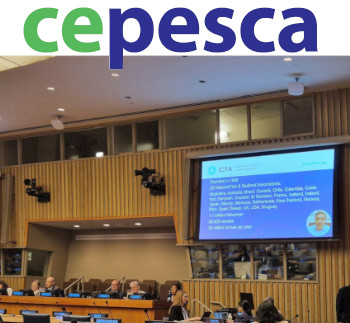|

Image: CEPESCA / FIS
Fishing Sector Calls for Essential Collaboration Between Governments and NGOs to Tackle the Challenge of Feeding a Growing Global Population
 WORLDWIDE WORLDWIDE
Friday, June 21, 2024, 07:00 (GMT + 9)
The fishing sector has appealed to the need to collaborate and work with governments and environmental NGOs if we want to guarantee the feeding of an estimated world population of 9.8 billion people in 2050. The fishing sector considers any strategy to address security a serious error. food of the planet to ignore fishery products as a primary source of food supply as they combine the unmatched quality of their protein and the low carbon footprint of their production.

Source: United Nations
This was stated by the Spaniard Julio Morón, president of the Spanish Fisheries Confederation (CEPESCA), at the 24th meeting of the United Nations Open Process of Informal Consultations on the Oceans and the Law of the Sea (ICP-24) of the UN .
 Source: FAO--> Source: FAO-->
Morón, who has spoken in this forum on behalf of the International Coalition of Fisheries Associations (ICFA), for its acronym in English, has asked governments and NGOs to be aware of the need to find the balance between conservation and use sustainable use of marine resources to alleviate pressure on the production of terrestrial resources, unable to meet the demand for food due to the general scarcity of land and fresh water. As an example, food production currently occupies more than half of the arable land and requires consuming 90% of fresh water[1].
During his presentation, Morón pointed out that effective fisheries management practices must be strengthened and promoted to maintain fish populations in good condition and recover those that are not in good condition to satisfy the growing demand for fishery products. In this regard, and as explained, the FAO SOFIA 2024 report indicates that global consumption of fishery products (excluding seaweed) increased an annual average of 3% during the period 1961-2019, a rate that almost doubles that of growth. of the world's population (1.6%) during the same period, with annual per capita consumption reaching a record 20.5 kilograms in 2019.
Likewise, and according to this same report, in 2021, 76.9% of landings came from fish stocks within the limits of biological sustainability; percentage that rises to 78.9%, considering the 10 marine species with the highest landings.
 FIS Seafood Media.jpg) According to Julio Morón, “in the fishing sector we are convinced that the time has come to address the health of our oceans as suppliers of food for a growing world population, in a serious, objective manner and with more weight of science and evidence. than the economic interests of different industries. In short, –adds Morón–, it is necessary that all interested parties who can collaborate towards a sustainable future for our oceans are able to engage in constructive dialogue.” According to Julio Morón, “in the fishing sector we are convinced that the time has come to address the health of our oceans as suppliers of food for a growing world population, in a serious, objective manner and with more weight of science and evidence. than the economic interests of different industries. In short, –adds Morón–, it is necessary that all interested parties who can collaborate towards a sustainable future for our oceans are able to engage in constructive dialogue.”
Finally, Julio Morón recalled during his speech that more than 3.3 billion people around the world depend on fish as a primary source of protein and drew attention to the richness of fish and seafood in essential nutrients that promote brain health. bones, eyesight and the immune system, and help reduce the risk of various chronic diseases, myocardial infarctions, strokes and arrhythmias.
[1] Study “The Future of Food from the Sea”, published by Nature magazine and developed by a group of scientists from the Oceans & Fisheries program of emLAB ((Environmental Market Solutions), from the University of Santa Barbara in California (United States).
Source: Cepesca (Translated from the original in Spanish)
[email protected]
www.seafood.media
|



